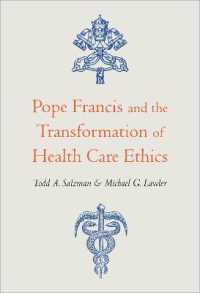- ホーム
- > 洋書
- > 英文書
- > Philosophy
Full Description
Life and Death in Freud and Heidegger argues that mortality is a fundamental structuring element in human life. The ordinary view of life and death regards them as dichotomous and separate. This book explains why this view is unsatisfactory and presents a new model of the relationship between life and death that sees them as interlinked. Using Heidegger's concept of being towards death and Freud's notion of the death drive, it demonstrates the extensive influence death has on everyday life and gives an account of its structural and existential significance. By bringing the two perspectives together, this book presents a reading of death that establishes its significance for life, creates a meeting point for philosophical and psychoanalytical perspectives, and examines the problems and strengths of each. It then puts forth a unified view, based on the strengths of each position and overcoming the problems of each. Finally, it works out the ethical consequences of this view. This volume is of interest for philosophers, mental health practitioners and those working in the field of death studies.
Contents
Foreword
Acknowledgements
Introduction
PART I: The Metaphysics of the Death Drive
One: Freud's Drive Theory
Two: The Development of the Death Drive
Three: Collapse of the Dualistic View
PART II: Give to Each His Own Death
Four: Being towards Death
Five: Towards a Relational Understanding of Death
PART III: Encounters between Freud and Heidegger
Six: Death Structuring Existence
Seven: The Ethics of Death
Eight: Death of Another
Nine: Death and Moods
Ten: Death and the Unconscious
Conclusion
About the Author
Bibliography
Index





